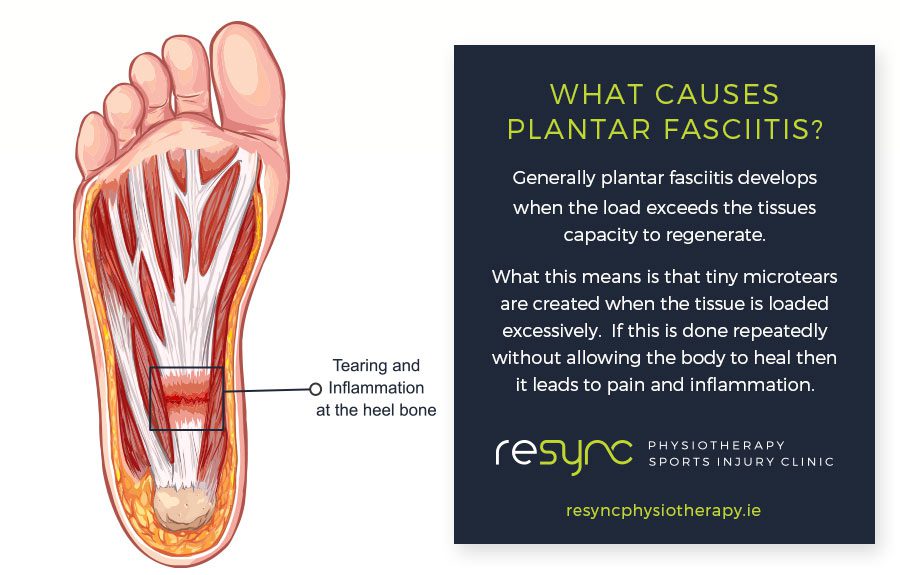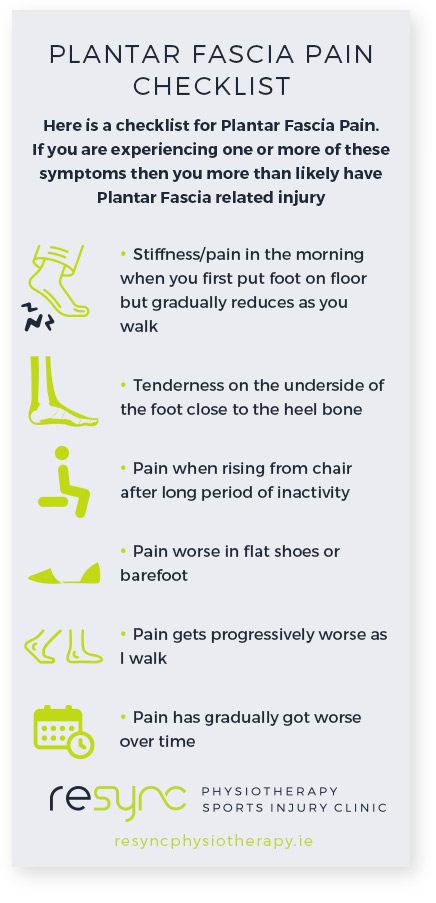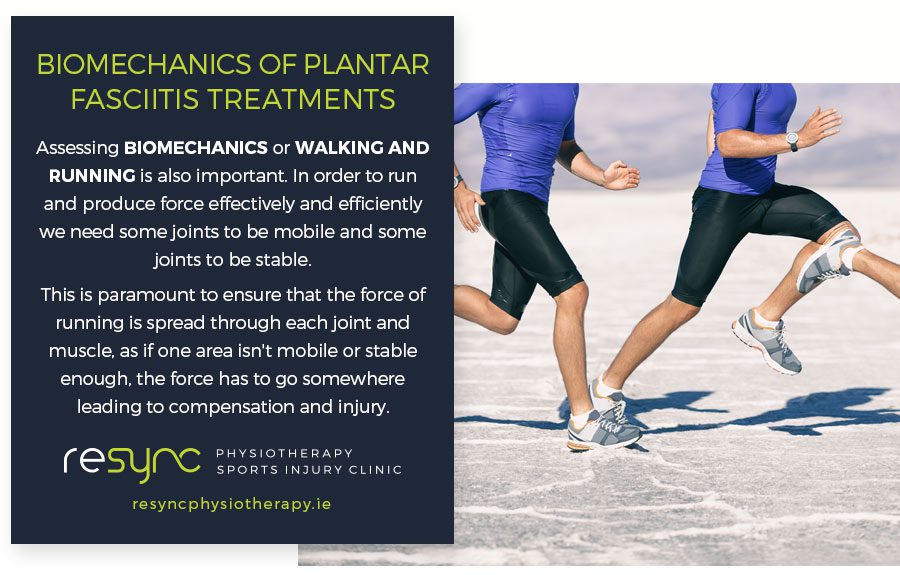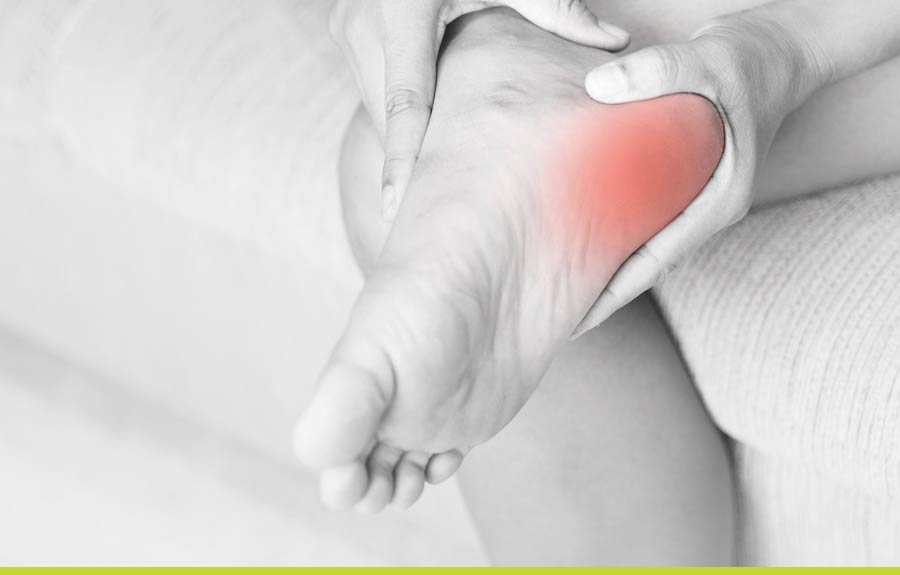In this post we’ll give you the info you need to know about plantar fasciitis and more importantly, plantar fasciitis treatments. In our last blog, we discussed Achilles Tendon Pain, the causes to recurring pain and with treatment and exercise you can help to prevent injury.
Plantar Fasciitis is an inflammation of the plantar fascia tendon located underneath your foot, close to your heel. It is made up of dense collagen which unlike other tendons in the body is very rigid. It needs to be this rigid as it is supporting the body’s entire weight when walking and is subjected to even higher loads when running.
Table of Contents
What Causes Plantar Fasciitis?
Plantar Fascia Pain Checklist
Facts About Plantar Fasciitis
Risk Factors for Plantar Fasciitis
What can we do to treat Plantar Fasciitis?
Biomechanics of Plantar Fasciitis Treatments
Preventing Plantar Fasciitis
Plantar Fasciitis Treatments – Schedule Yours Now
“Planter fasciitis develops when the load exceeds the tissues capacity to reberate. With treatment you can resolve this pain and get back to normal running.”
Plantar Fasciitis is an inflammation of the plantar fascia tendon located underneath your foot, close to your heel. It is made up of dense collagen which unlike other tendons in the body is very rigid. It needs to be this rigid as it is supporting the body’s entire weight when walking and is subjected to even higher loads when running. In this post we’ll give you the info you need to know about plantar fasciitis and more importantly, plantar fasciitis treatments – read on!
What Causes Plantar Fasciitis?
Generally plantar fasciitis develops when the load exceeds the tissues capacity to regenerate. What this means is that tiny micro-tears are created when the tissue is loaded excessively. If this is done repeatedly without allowing the body to heal then it leads to pain and inflammation. Obviously it is hard to rest your feet once they get irritated as we need these to walk!

Let’s say you go walking on a beach for 40 mins when on holidays, our Irish legs are not used to walking on an unstable surface (sand) so your plantar fascia and all other muscles uses to walk are working a lot harder to keep you upright and moving as they have to adjust to the moving sand below your feet. Due to this the plantar fascia develops micro-tears. These micro tears occur daily in our body but when a structure is subjected to repeat micro-tears over the course of a week’s holiday, then it becomes painful and needs time to rest. This then causes a cycle of pain and inflammation within the tendon.
Plantar Fascia Pain Checklist
 Ok so here is a checklist for Plantar Fascia treatment and pain. If you are experiencing one or more of these symptoms then you more than likely have Plantar Fascia related injury.
Ok so here is a checklist for Plantar Fascia treatment and pain. If you are experiencing one or more of these symptoms then you more than likely have Plantar Fascia related injury.
- Stiffness/pain in the morning when you first put foot on floor but gradually reduces as you walk
- Tenderness on the underside of the foot close to the heel bone
- Pain when rising from chair after long period of inactivity
- Pain worse in flat shoes or barefoot
- Pain gets progressively worse as I walk
- Pain has gradually got worse over time
If you have the above pains then don’t worry as you are not alone and plantar fasciitis can be treated!
Facts About The Injury
Here are some fun facts about plantar fasciitis treatment:
- Accounts for about 10% of runner-related injuries (some literature shows prevalence rates among a population of runners to be as high as 22%)
- Thought to occur in about 10% of the general population
- 83% of these patients being between the ages of 25 and 65 years old
- 11% to 15% of all foot symptoms requiring professional medical care.
- May present bilaterally in a third of the cases.
- The average plantar heel pain episode lasts longer than 6 months and it affects up to 10-15% of the population.
- Approximately 90% of cases are treated successfully with conservative care meaning that physiotherapy is more favourable than injections / surgery.
- More common in females than males.
- Diabetes or a high BMI increases your risk of developing it.
Risk Factors
There are certain risk factors for developing plantar fasciitis, both extrinsic and intrinsic.
Here is a list of potential extrinsic Factors (this refers to patterns of load that the tendon is subjected to outside of the body): long walks, spending all day on feet, running on surfaces with little give (eg, roads), running/walking on surfaces with too much give (eg, sand) and wearing poor footwear (eg, flat shoes, flip flops).
Some intrinsic risk factors, factors which involve the current condition of your body and supporting structure, include: high body mass index, tight calves and stiff ankles, fallen arches (flat feet), weak muscles in the foot, poor big toe extension (causes more stress on plantar fascia), poor walking mechanics (walking different due to pain).

What options are for Plantar Fasciitis Treatment?
When trying to treat plantar fasciitis the the initial goal is reducing pain. We then focus on correcting the extrinsic factors to allow the foot to settle down and finally, we focus on correcting the intrinsic factors.
We can first reduce the pain by a number of means such as, shockwave therapy, icing, anti inflammatories, advise and education regarding activities and specific exercises.We can change extrinsic factors by educating you on painful triggers of plantar fascia pain, managing activity levels so you don’t continuously irritate the Plantar Fascia, provide orthotics to support the arch of the foot, taping foot to provide support of arch of the foot and acupuncture.
We can treat the intrinsic factors by stretching, myofascial release, joint manipulations, strengthening the Plantar fascia and intrinsic muscles in the foot, assessing and strengthening the whole body especially the hips and legs, assessing and improving biomechanics and provide a progressive tailored return to activity program.

Biomechanics of Plantar Fasciitis Treatment
Intrinsic factors that can also lead to plantar fascia pain include strength and control of your ankles, knees, hips and core. Assessing biomechanics or walking and running is also important. In order to run and produce force effectively and efficiently we need some joints to be mobile and some joints to be stable. This is paramount to ensure that the force of running is spread through each joint and muscle, as if one area isn’t mobile or stable enough, the force has to go somewhere leading to compensation and injury.
For example you need stability in your foot, mobility in your ankle, stability at your knee, mobility in your hips and so on. This continues up to your head with intermittent stable and mobile joints stacked on top of each other. We look at the body as a WHOLE. We assess each joint and area individually but also look at how your body is functioning together as a unit to provide a lasting treatment to your plantar fasciitis.
Preventing Plantar Fasciitis
When we run we need to be able to rotate through our body. As you push off your left leg your right shoulder whips back and your upper body rotates. What we do differently is look at these muscular slings and your ability to rotate: can you effectively rotate your hips white rotating your upper body in the opposite direction etc. All of these factors are important to dissipate the load through your body so this is why it is important to work on these areas and all of the potential causes of the issue rather than just treating them symptoms in the foot alone. This ensures that we not only get you back to doing what you love doing but also prevent it from recurring so you don’t have to put up with it again!




